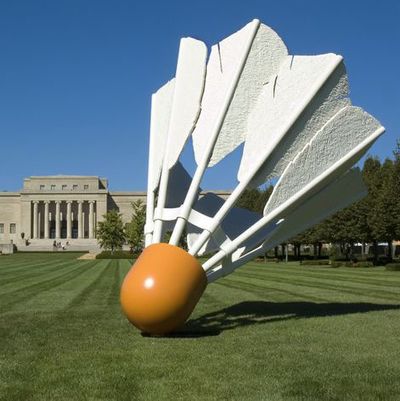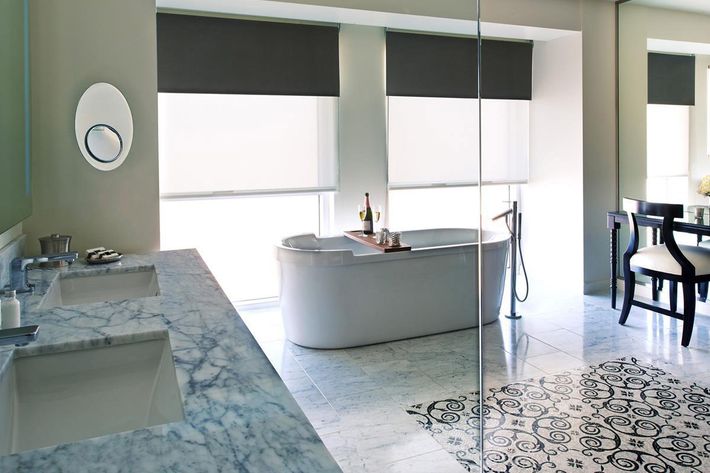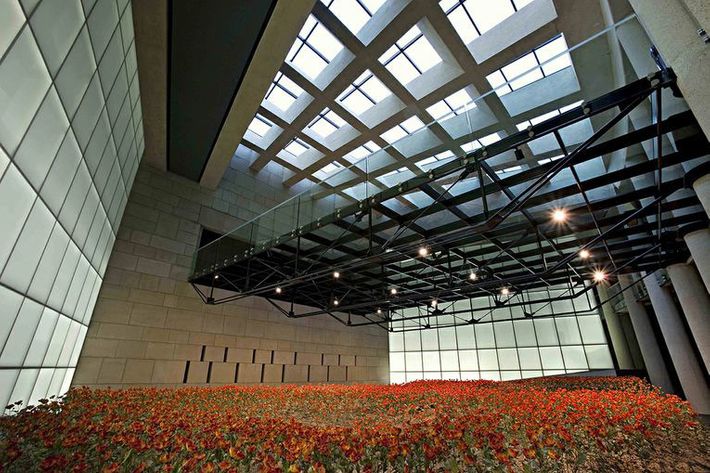
Plan your trip to Kansas City around the city’s barbecue, jazz, and baseball foundation, then explore revitalized art-focused districts, speakeasies, a diversifying food scene, and refreshed boutique hotels.
Where to Stay

Book one of the spacious rooms at the recently renovated boutique hotel the Fontaine, a chic oasis near the Country Club Plaza (from $139). Guestrooms are designed in calming shades of gray, cobalt blue, and white, and feature spalike white-marble bathrooms with rain showers to provide instant relaxation. Start mornings with a Mediterranean-meets-American buffet breakfast (think full yogurt bar and French pastries alongside scrambled eggs and bacon) in the sunlight-drenched Solarium Lounge, then spend a warm afternoon lounging by the hotel’s rooftop pool. While you’re in town, save one evening for dinner at Parker, the Fontaine’s new rooftop restaurant. The cuisine is “progressive American”: Cornbread is served with honey cream cheese, dill, and aged Cheddar ($5), while the signature Parker spiced shrimp ($14) appetizer nods to Bloody Mary flavors of tomato, celery, and pickled red onion. For an entrée, try Parker’s brick chicken with mushroom farro and charred broccolini ($25).
The massive columns, soaring ceilings, and beautiful crown molding in the lobby of the Ambassador Hotel Kansas City (from $299) make it easy to visualize its past life as the Gate City National Bank in 1920. After a multimillion-dollar renovation in 2012, the neoclassical structure reopened as the fourth property in the Ambassador Hotels collection. The 43 guestrooms are filled with natural light thanks to oversize windows, but you’ll probably want to pull the drapes so you can stay in the luxe linens all day. Have a predinner drink from the extensive wine list at the hotel restaurant, Reserve, before heading out for a night in downtown KC.
As the only hotel located in the newly minted Power & Light District, an entertainment district conceptualized and created by Baltimore-based real-estate development group the Cordish Company, the Hilton President Kansas City (from $189) is the ideal place to be to get a taste of the city’s past and future. Opened in 1926 as one of Kansas City’s original grande-dame hotels, the property has hosted both past presidents and entertainers, including Harry Truman, Sammy Davis Jr., and Bob Dylan, and is a National Historic Landmark. Even after last year’s $5 million renovation, Hilton President keeps its vintage feel alive thanks to gold and crystal chandeliers and peach-marble columns in the lobby lounge. Rooms are classic and understated, with regal touches of navy blue and gold.
Where to Eat

When it comes to barbecue in Kansas City, everyone has an opinion. The barbecue scene is distinctly divided between old school and new, with traditionalists preferring to stick with time-honored, no-frills BBQ plates. For old school, head straight to Gates Bar-B-Q, a family-owned Kansas City staple since 1946. Try to know your order in advance, because the company motto is “Hi, may I help you?” and staff members joyfully shout the question the moment you walk in the door. You can’t go wrong with a smoky burnt-ends sandwich ($8) or a plate of perfectly seasoned, falling-off-the-bone center-cut ribs and a side of extra-crispy fries ($14). On a new-school-barbecue menu, like the one at Q39, you’ll find modernized interpretations of classics, like pork belly and sausage corn dogs ($10), a burnt-end burger (grilled ground brisket and Angus-beef patty) topped with slice burnt ends and spicy pickle slaw ($12), and sides of apple coleslaw ($3) and white-bean cassoulet ($3).
Indulge in authentic Northern Italian cuisine at Lidia’s Kansas City, a 20-year staple of the Kansas City dining scene, housed in a 130-year-old former railroad house near historic Union Station. Although the restaurant seats more than 250 people, vaulted wood-beamed ceilings, exposed-brick walls, and large chandeliers of richly colored hand-blown glass bottles give the space a warm and cozy feel. Bring your appetite, because you’re going to want to cover each area of the menu, starting with the frico, a classic dish from Northeast Italy of crisp-fried Montasio cheese stuffed with potatoes, leeks, sausage, and apples ($13). It is heaven. For pasta, stick with the signature Lidia’s Pasta Trio ($22), a daily-rotating selection of three housemade pastas — one meat, one seafood, one vegetarian. If you have space for secondi, try the grilled salmon fillet with Yukon potatoes and mustard sauce ($24). Dessert is the tiramisu, obviously ($8.50).
In a city accustomed to traditional notions of three squares a day, a restaurant boasting a menu of small plates was a bit of a risk that paid off. Opened in 2017, Corvino Supper Club & Tasting Room is one of the most talked-about new restaurants in Kansas City. The seasonally rotating menu is equal parts whimsical and global. Recent dishes have included charred octopus with smoked buttermilk, grapefruit, and ink vinaigrette ($18); crispy pork ribs with fish sauce, fried garlic, and crushed peanuts ($16); and smoked Cheddar grits with rock shrimp, country ham, and a soft egg ($14). The sleek gray-, black-, and lavender-hued restaurant offers live music every night, a strong list of creative cocktails (and fancy mocktails), and tableside Champagne and caviar service for two ($250).
What to Do

For a true taste of Kansas City’s African-American history and culture, head to the historic 18th and Vine District. The area, born out of segregation, became the center of African-American life in the 1920s, with flourishing retail businesses, entertainment venues and clubs, churches, and recreational facilities. It was also a big draw for African-American celebrities, like jazz musicians Count Basie, Ella Fitzgerald, and Louis Armstrong, who opted to perform and socialize in clubs and theaters in the area knowing they wouldn’t face the discrimination usually waiting for them in other parts of the city. Start your exploration of this district at its nucleus, the 10,000-square-foot shared space of the American Jazz Museum and the Negro Leagues Baseball Museum (entry to both museums $15). The former is a mixture of interactive touch-screen displays, memorabilia, films, listening stations, and mixing boards to create your own melodies. The latter charts the rise and eventual demise of the Negro Leagues, the professional baseball leagues of African-American men (and women!), and their effect on black society. The artifact-rich museum expertly chronicles the life of the leagues in relation to American history as a whole, providing excellent context and topics for discussion. Across the street is the Gem Theater, a former movie theater turned performing-arts venue that hosts an annual jazz-masters concert series. Finally, if you can stay awake, visiting the Mutual Musicians Foundation is a must. Founded in 1917, the intimate club hosts local musicians for improv jam sessions on Fridays and Saturdays after midnight until six in the morning. Note: Even though it opens at midnight, the place doesn’t get jumping until around 4 a.m., so grab a Red Bull and don’t bother arriving until three.
Toast to Kansas City’s well-documented aversion to Prohibition by visiting the first distillery to open in the city since the enactment of the 18th Amendment in 1920. Opened in 1887 in the West Bottoms neighborhood along the Kansas and Missouri state line, J. Rieger & Co. was the largest mail-order whiskey company in the United States before being forcibly shuttered in January 1920 (making it possibly the last distillery to close). Six generations later, in 2014, Andy Rieger and co-founder Ryan Maybee purchased the original family trademark and relaunched the brand. On select Saturdays, tour the 15,000-square-foot facility in the East Bottoms for a peek into the distilling process and a sample of whiskey, gin, vodka, caffè amaro, and special releases ($16.27). Don’t forget to ask to see the secret tunnel in the basement. Continue with the Prohibition vibes at Swordfish Tom’s, today’s version of a genuine speakeasy — back-alley location, red-light-green-light mode of entry, and 30-seat capacity. The cash-only spot has a thick menu of bespoke cocktails with fun quirks like absinthe, smoke infusions, and candied flowers.
Hunt for unique works by local artists in the Crossroads Arts District. In the 1980s, retired Kansas City Art Institute professor Jim Leedy began purchasing the blighted abandoned warehouses in the area and converting them into artists’ studios and galleries for students. In the past three decades, the area has transformed into one of the most concentrated gallery districts in the nation, boasting more than 100 arts-focused entities, including independent shops, galleries, restaurants, and performing-arts spaces. Visit the working clay studio and gallery space of Archival Designs to watch the creation process of hand-thrown pottery, or take in a jazz performance and sip cocktails in a red leather booth at the Green Lady Lounge. Pick up souvenirs like “816”-printed postcards (Kansas City’s area code) ($2.50) at Hammerpress Letterpress + Design Studio, and shuttlecock-printed pint glasses ($13) and koozies ($3) at Midwest-based design and clothing company Raygun. (Four 18-foot-tall badminton-shuttlecock sculptures are scattered across the lawn of the Nelson-Atkins Museum of Art — see image at top of page. They’re something like the city’s unofficial mascots.)
Expert’s Tips
Mr. Ollie Gates, the son of Gates and Son’s Bar-B-Que founder George Gates, is the CEO of Gates Bar-B-Q. Born and raised in Kansas City, he has continued to serve his community by renovating the historic Satchel Paige Memorial Baseball Stadium, beautifying local parks, and building a memorial to African-American veterans of both world wars. He has no plans to slow down anytime soon.
Well, I’d definitely recommend our other Gates location at 12th and Brooklyn Avenue. You can find everything in that area, from barbecue to Chinese food to soul food. For soul food, visit The Peach Tree for either the buffet or cafeteria. There’s also Niecies Restaurant, Lutfi’s Fried Fish, and Charlie D’s. I think they all qualify for national attention and all have great food.
When folks come to visit the 18th and Vine historic district to see the museums, they should also go to the Kansas City Juke House, owned by the Shelby brothers, for drinks and live music, as well as the Blue Room for jazz performances. They can also stop for a New Orleans–inspired meal across the street from the museums at Bayou on the Vine.
Swope Park is an 1,800-acre park with two golf courses. Also visit the Kansas City Zoo, Starlight Theatre, a great outdoor amphitheater, and the Lakeside Nature Center, which helps to rehabilitate wild animals.

I’d also recommend the National World War I Museum and Liberty Memorial. I was very instrumental in helping to put the museum together.